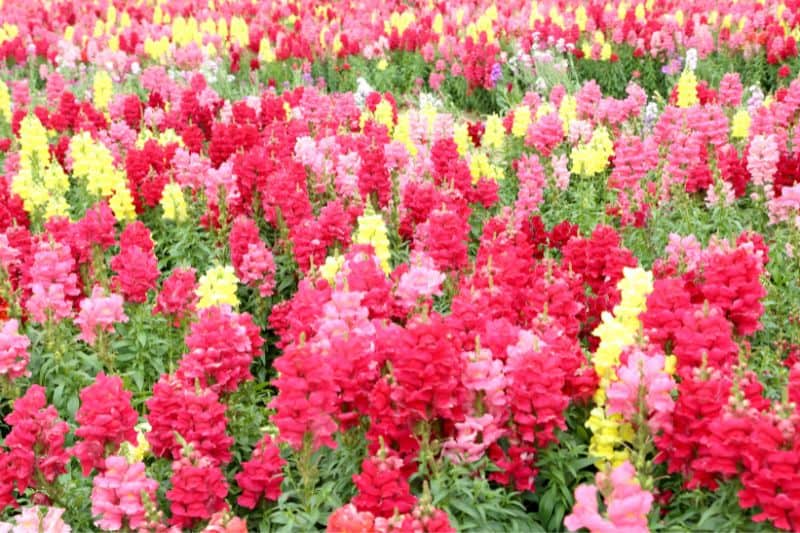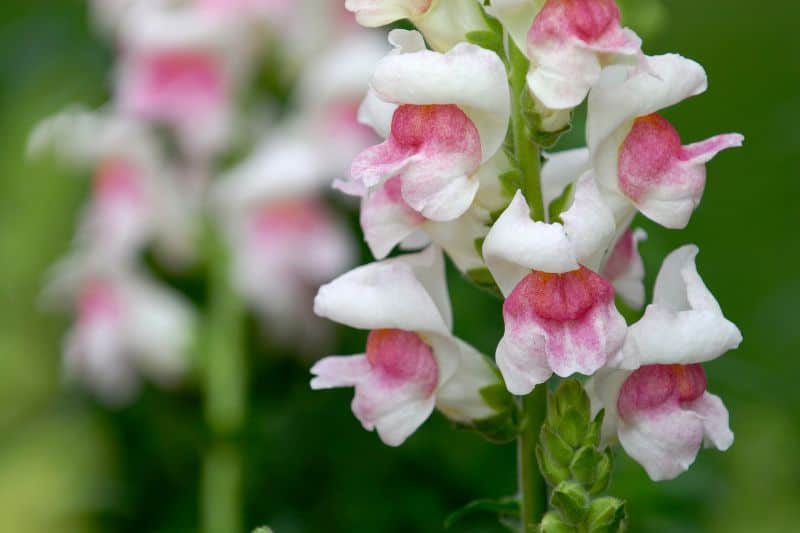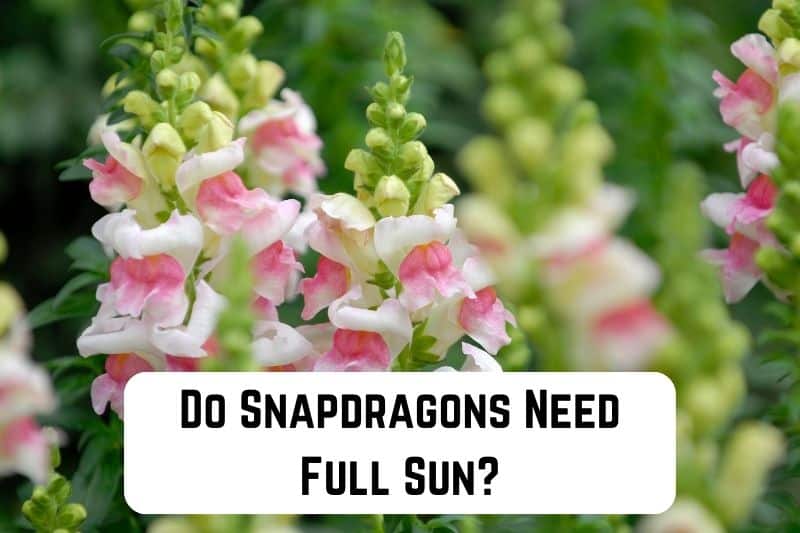Snapdragons are a popular flower bed choice due to their long spiky form and illustrious colorful blossoms. But, the annuals need the right growing conditions to fully blossom to their stunning potential. Among the growing factors to consider is do snapdragons need full sun.
Climate and natural lighting are essential in creating ideal growing conditions for most flowering plants. Too little or too much sun determines how beautifully flowers blossom and impacts the plant’s survivability. If you want to know about the sunlight needs of snapdragons, you can find your answer in this guide.
Read: Do Marigolds Need Full Sun?
Do Snapdragons Need Full Sun or Shade?
Natural lighting plays a significant role in the growth and development of snapdragons. Sunlight even influences the spiky showy blossoms these annuals grow in spring and summer. While snapdragons come in several subtypes, they all boast similar natural lighting needs.
Snapdragons need full sun to produce abundant and healthy blossoms. The longer snapdragons are exposed to sunlight, the better and more flowers they produce. While these flowering plants can tolerate partial shade, they don’t produce as many flowers in these conditions.
Snapdragons perform the best in full sun in well-drained and moist soil conditions. However, the annuals prefer cool climates and can suffer in high heat. This explains why they enjoy direct sunlight exposure in spring through early summer – before the intense late summer heat. Snapdragons bloom the most during this period and decline towards the end of summer.
Snapdragons can also grow in pots or containers indoors off-season (from late summer through winter) with access to natural lighting. You can place them near a window to get them adequate lighting or add artificial lighting. But, you’ll have to move them outdoors during spring and get them back indoors by late summer.
Can Snapdragons Grow in Shade?
Snapdragons cannot grow in full shade. Growing snapdragons in the shade will not kill the plant, however, no flowers will be produced. During spring to early summer, snapdragons need to grow in full sunlight to produce their beautiful blossoms.
As it begins to heat up more intensely during late summer, you can place the annuals in a partially shaded area to protect them from intense heat or move them indoors. Like full shade, intense heat slows down and stops snapdragons altogether from producing flowers.
Placing snapdragons in partial shade still promotes flower production – albeit at a lower rate. The good news is that snapdragon blossoms may reappear in fall for a few weeks if you protect them from the intense late summer heat.
Note: If you live in hot climates, you can move your snapdragons earlier or grow them in partial shade. You will have fewer flowers (than in ideal sunlight conditions), but, your annuals will bloom, nonetheless.

How Many Hours Of Sun Do Snapdragons Need?
Snapdragons need at least 6 to 8 hours of direct sun every day. In partial shade, you need to extend this period to at least 10 to 12 hours. However, snapdragons need a balance when exposed to sunlight. Since they prefer cooler climates, the heat that comes with prolonged sunlight exposure can be a problem.
For the best results, fully expose snapdragons to the cooler morning sun and place them in partial shade during the hot afternoon sun. You don’t need to do the back-breaking task of moving the plants every few hours to achieve this balance.
There are plenty of ways to provide full sun in the morning and partial shade in the afternoon without moving the plants. Here’s what you can do;
- Plant snapdragons in east-facing flower beds or window boxes
- Pair them near a larger plant, shrub, or tree that casts partial shade in the afternoon
- Place them under thick vining plants
- Invest in a 70-90% density shade cloth or shade sail
- Add a water feature to create shade, cool the area, and boost soil hydration
What Happens if Snapdragons Don’t Get Enough Sun?
Snapdragons fail to produce flowers when they don’t get enough sun. But, too little sun or the lack thereof creates other issues for the annuals. Fortunately, snapdragons that don’t get enough sun bear telltale signs.
If snapdragons don’t get enough sunlight, you will notice;
- Long and leggy appearance
- Little to no flower blooming
- If flowers bloom, colors won’t be as bright and vibrant
- Increased risk of disease and pest infestation
- Overall unhealthy plant appearance
- Stunted growth
- In full shade, snapdragons will get leggy, taller, and fall over
Can Snapdragons Get Too Much Sun?
While sun-loving, snapdragons can get too much sun. The problem with extended direct sunlight exposure is extreme heat. Unlike the sun alone, heat does more damage than good to snapdragons.
6 to 8 hours of sunlight exposure daily is sufficient for snapdragons to thrive. Anything beyond this can potentially damage the plants. This is enough time for the plants to enjoy the cooler morning to early afternoon sunlight. They can get the remaining natural lighting during the hotter afternoon sun sheltering in partial shade.
However, the sun intensifies and gets hotter later in summer. You may have to cut down the amount of hours you expose snapdragons to direct sun. Alternatively, you can permanently move them to a partially shaded area, ensuring they get just enough sun without the damage.
Prolonged exposure to sunlight exposes snapdragons to dangerous heat levels, especially the afternoon sunlight. Warmer and tropical climates are also prone to high heat and humidity. Snapdragons thrive best in temperatures between 60 degrees Fahrenheit and 75 degrees Fahrenheit. Anything over 90 degrees Fahrenheit and with no breeze doesn’t favor the annuals.
Here’s what too much heat from prolonged sunlight exposure does to snapdragons;
- Reduced flower production
- Discolored blossoms
- Burnt leaf edges
- Dry brown textured and yellow colored stems
- Stunted growth
- In prolonged extreme heat, snapdragons get dehydrated and die off
Fortunately, you can reverse the symptoms when you identify this problem sooner. As long as there isn’t massive damage or plant death, you can revive sun and heat-damaged snapdragons by moving them to a partially shaded spot. If you live in a hot and humid climate, permanently keep them in a partially shaded garden area.

How To Plant & Care For Snapdragons?
Snapdragons are classified as annuals, meaning they complete their life cycle within a year. Annuals germinate and produce seeds within a single growing season and die. However, snapdragons are usually grown as perennials – allowing them to persist for more than a year. While they are short-lived, with a spring-to-summer (and sometimes, fall) blooming period, they handle overwintering.
Proper plant care will have your snapdragons survive a good 3 to 5 years. Moreover, it guarantees healthy, flourishing, and abundantly growing snapdragons. Snapdragons usually bloom from spring through summer. However, you will also enjoy a second brief blooming period during fall with proper plant care.
Here are essential tips for the best snapdragon results;
Provide Ample Sunlight
- Give snapdragons at least 6 to 8 hours of full sun
- Morning sun is usually cooler and more beneficial
- Partial shade is better in the hotter afternoon sun or late summers
- Grow snapdragons in partial shade if you live in a hot and humid climate
Choose Well-Drained Soils
- Grow snapdragons in well-drained soils with no waterlogging
- Keep the soil pH at 6.2 to 7.0
- Enrich the soil with a balanced fertilizer to boost rich flower production
- Regularly water snapdragons to keep them hydrated
- Seedlings need to stay moist
- Established snapdragons will do with at least an inch of water weekly
Maintain Air and Temperature Quality
- Heat and humidity damage snapdragons so avoid them at all costs!
- Grow snapdragons in temperatures lower than 90 degrees Fahrenheit (at least 60 to 75 Fahrenheit).
- East-side planting ensures full, cool morning sun and partially hot afternoon sun exposure.
- Companion planting simultaneously tackles humidity, lack of air circulation, and heat.
- Canopy trees, trailing vines, evergreen foliage, and ornamental plants are excellent companions for snapdragons.
- Trailing vines, textured evergreen foliage plants and ornamental plants add extra interest to your garden.
- Add a water feature to counter humidity, heat, and drought/dehydration.
- You can also space out the plants to promote air circulation.
Read: Do Coneflowers Need Full Sun?
Do’s and Don’ts of Snapdragon Planting
- Get less heat-sensitive snapdragon cultivars if you live in hot, humid, or coastal areas
- Sow snapdragons in fall through early spring to enjoy blossoms in summer
- Transplant seedlings when you see the first three to four true leaves
- Transplant seedlings a week or two from the last frost date
- Avoid overfertilizing them – doing this will burn the plants!
- Flush the soil with water if your snapdragons are fertilizer-burnt
- Too much water or humidity invites root rot, pests, and diseases
- Prune taller snapdragons to prevent flopping due to height and weight
- Deadhead snapdragon blossoms during summer to stimulate new blooms
- Frequently examine the plant to check for pests or diseases
- Treat light infestations with water or DIY solutions
- Aphids, whiteflies, and mealybugs love to hide on leaf undersides
- Remove dead leaves and other debris to prevent fungal outbreaks or mold build-up






